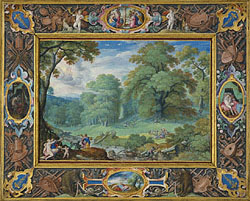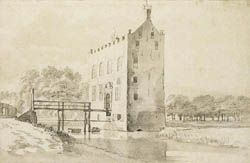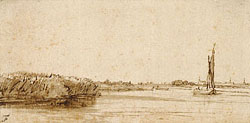|
At the end of the 16th century, courtly patrons such as Holy Roman Emperor Rudolf II (1552–1612) of Prague began to acquire drawings.
These drawings formed part of their encyclopedic collections, called art cabinets (kunstkammers in Dutch).
Exquisitely crafted works like this gouache miniature (right) were often kept in kunstkammers, which juxtaposed fantastic human artifice with the wonders of nature.
|
 |
|
 |
Amassing Great Collections
In the mid-1600s, Dutch artists helped to further popularize the collecting of drawings. Artists acquired drawings from their colleagues and sometimes inherited their whole studios. Rembrandt van Rijn collected hundreds of drawings, including sheets by Dutch artists.
Following the example set by artists, wealthy 18th-century Dutch merchants and professionals also began to collect drawings.
One of the most exceptional 18th-century collections belonged to Cornelis Ploos van Amstel, a timber trader and print publisher and the founder of the Amsterdam Art Academy. The drawing of the Castle Giessenburg (right) was once part of his collection.
|
 |
|
 |
Annotating Drawings
Collectors stored their drawings in large, leather-bound albums and arranged them by subject matter. They often kept them unbound in order to make notations about attributions, provenance, and storage chronology on the back.
This mountain landscape (right) belonged to two important 18th-century collectors. Inscriptions on the back of the sheet indicate that it was the 27th sheet in the 20th album belonging to Valerius Röver of Delft.
In 1761 Amsterdam banker Johann Goll van Franckenstein bought the drawing when he acquired Röver's entire collection of 2,200 drawings.
Collectors' Marks
Collectors gathered to discuss their drawings at art viewings. These lively events took place in the evenings at the homes of collectors, fostering a shared enthusiasm for paper art (in Dutch, papierkunst).
|
 |
|
 |
Drawings enthusiasts also stamped their drawings with their unique collector's marks. The mark was evidence both of ownership and of their knowledge and taste.
This atmospheric riverscape by Rembrandt (right) has a prominent collector's mark, the large black F in its lower left corner.
This F stands for one of the previous owners of this drawing, Nicolaes Anthonis Flinck. Flinck was a renowned collector, a director of the Dutch East India Company, and the son of one of Rembrandt's pupils, Govaert Flinck. |
 |
|
 |



